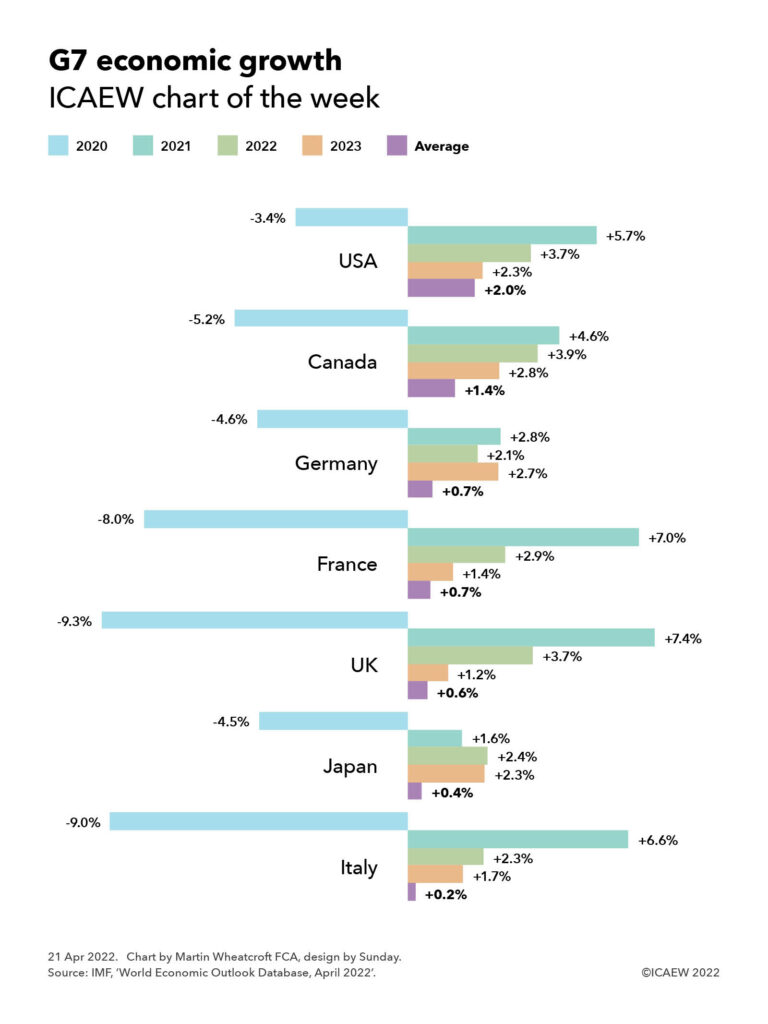The latest IMF economic forecasts put the UK at the bottom of the pile in 2023, but our chart this week elevates the UK to fifth place out of seven by looking at average growth for the four years from 2020 to 2023.

Recent media reports have contrasted the government’s boast of being the best performing economy in the G7 in 2021 with the latest forecasts from International Monetary Fund (IMF) that suggest the UK economy will be bottom of the same league in 2023. Our chart this week attempts to take a step back and look at the overall picture by illustrative average economic growth by the G7 nations over the four years between 2020 and 2023.
These numbers are based on the IMF’s World Economic Outlook and the accompanying World Economic Outlook Database that were published on 19 April, setting out economic forecasts for the world economy over the next few years.
According to the IMF, the USA is the best performing economy in the G7, with average annual economic growth of +2.0% over the period from 2020 to 2023. An economic contraction of 3.4% in 2020 was more than offset by a rebound of 5.7% in 2021, followed by forecast growth of 3.7% in 2022 and 2.3% in 2023. Canada is not far behind, with an average growth of 1.4% over the four years, comprising respectively -5.2%, +4.6%, +3.9% and +2.8% in 2020, 2021, 2022 and 2023.
Germany and France fare pretty similarly to each other, with Germany projected to experience marginally above 0.7% average growth and France marginally below. The patterns are different, however, with Germany having suffered a less severe economic hit during 2020 followed by moderate growth (-4.6%, +2.8%, +2.1%, 2.7%), while France was hit much harder by the pandemic followed by a much stronger rebound before a return to lower growth in 2023 (-8.0%, +7.0%, +2.9%, +1.4%).
The UK is in fifth place in this league table, but at 0.6% average economic growth over the four years selected this is only slightly less than Germany and France. With an economic contraction in 2020 of 9.3%, the UK suffered more severely from the pandemic than the other members in the G7 (although this is partly because of differences in statistical methodologies) but then saw the biggest rebound in 2021 with growth of 7.4%. Growth this year is forecast by the IMF to be 3.7% before falling to an (unfortunately) more typical level of 1.2% in 2023.
Vying for the wooden spoon are Japan and Italy, with Japan continuing a long period of low growth and a slower recovery from the pandemic than the others to average 0.4% a year (-4.5%, +1.6%, +2.4%, +2.3%). Italy secured the bottom position by virtue of being hit hardest by the pandemic and having less of a rebound than others (-9.0%, +6.6%, +2.3%, +1.7%), a net average growth rate of 0.2% over the four-year period.
For those that follow this particular league table, there is a hope that slightly stronger growth than the IMF has forecast could move the UK up one or two places above France and/or Germany. However, the bigger concern for most of us is about the downside risks to the global and UK economies from the war in Ukraine, rampant inflation, and a global cost of living crisis. These may put back even further any hope of returning the UK and other developed economies to a pre-financial crisis path of moderate economic growth.